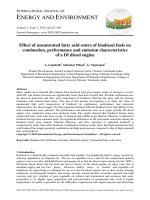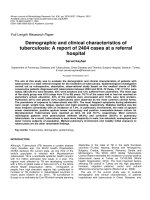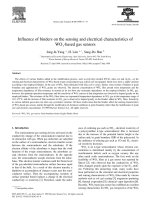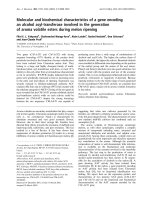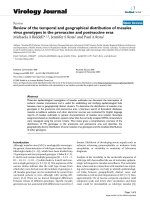Nutritional and physicochemical characteristics of foxtail millet genotypes
Bạn đang xem bản rút gọn của tài liệu. Xem và tải ngay bản đầy đủ của tài liệu tại đây (168.9 KB, 6 trang )
Int.J.Curr.Microbiol.App.Sci (2019) 8(1): 1773-1778
International Journal of Current Microbiology and Applied Sciences
ISSN: 2319-7706 Volume 8 Number 01 (2019)
Journal homepage:
Original Research Article
/>
Nutritional and Physicochemical Characteristics of
Foxtail Millet Genotypes
Shilpa Huchchannanavar1*, L.N. Yogesh2 and S.M. Prashant2
1
ICAR-KrishiVigyan Kendra 2Agricultural Research Station, Hagari, Ballari-583111
University of Agricultural Sciences, Raichur, India
*Corresponding author
ABSTRACT
Keywords
Millet, Nutrition,
Health, Fat, Fibre,
Protein
Article Info
Accepted:
12 December 2018
Available Online:
10 January 2019
Nutritional and physico-chemical properties are very important factors in food product
development in this regard a study was carried out to know the nutritional and physicochemical characteristics of nine foxtail millet genotypes developed at Agricultural
Research Station, Hagari along with the check variety. The genotype HN-46 recorded
highest 1000 grain weight. The volume of thousand grains was high inHN-13 (2.5 ml). The
bulk density of ten genotypes ranged from 0.75 to 2.20. The protein content of HMT 1001(13.29g) was high among all the genotypes followed by HN-43 genotypes (13.10 g), The
fat content of HMT 100-1 was high (3.83) whereas the lowest fat content was in the
genotype HN-43 (2.80). The crude fibre in HN-43 was more (2.98) whereas the total
mineral content was high in Sia3162 and HN-46 (2.0g). The Energy value of HMT100-1
(3.79) was high compared to other genotypes. The low calorific value was noted in HN-46
and Sia 2644 (363 Kcal).
Introduction
Millets are the super grains with reservoirs of
nutrients. Millets were indeed oldest foods
known to humans. Due to rice and wheat
obsession these crops were neglected from
past few years. Millets are major food sources
for millions of people, especially those who
live in hot, dry areas, hilly region with low
rain fall. India is the largest millet producing
country in the world with a total area of 23
million ha and these nutri-cereals alone
account for about 3.5 million hectare (Stanly
and Shanmugam, 2013). The major millets are
pearl millet, foxtail millet, proso-millet, little
millet and finger millet. Among the millets
foxtail millet is underutilized grain grown
across the world. It grows well even under
adverse agro-climatic conditions. Foxtail
millet is non-glutinous and non-acid farming
and easy to digest. Foxtail millet is also a good
source of energy, fats, proteins, fatty acids,
vitamins, minerals and dietary fibre. Foxtail
millet proteins contain good sources of
essential amino acids except lysine and
threonine but have relatively high quantity of
sulphur containing amino acids (methionine
and cysteine). Foxtail millets are rich sources
of phytochemicals, micronutrients and
antioxidants, such as phenolic acids and
1773
Int.J.Curr.Microbiol.App.Sci (2019) 8(1): 1773-1778
glycated flavonoids. Foxtail millets, with their
low Glycemic index value, high dietary
fibreand water soluble gum content (b-glucan)
have been attributed to improve glucose
metabolism. These grains release sugar slowly
to blood. The dietary fibre and resistant starch
of these nutri-cereals have been attributed to
exhibit hypoglycemic and hypolipidemic
effects. Millet grains have antioxidative
properties against oxidative stress, which is
mainly determined by their higher reserves of
phytochemicals like phenolics, tannins,
phytates and micro minerals etc. Because of
the high nutritive value and the functional
ingredients present in it, foxtail millet is
considered as neutraceutical grain. An
experiment was conducted to evaluate the
genotypes developed at Agricultural Research
Station, Hagari, University of Agricultural
sciences, Raichur for their physico-chemical
and cooking qualities.
Cooking characteristics
Cooking time
Cooking time of each millet genotype was
determined by boiling 2.0 g of whole millet
grains from each millet genotypes in 20ml of
distilled water, removing a few grains at
different time intervals during cooking and
pressing them between two glass plates until
no white core was left. Optimum cooking time
was taken as the established cooking time plus
two additional minutes.
Water uptake ratio
The water uptake ratio was determined by
cooking 2.0 g of whole millet grain from each
genotype in 20ml distilled water for a
minimum cooking time in a boiling water bath
and drain the superficial water from the
cooked millet.
Materials and Methods
Ten foxtail millet genotypes (including check)
developed at Agricultural Research Station,
Hagari were used for present study and the
experiment was conducted at ICAR-Krishi
Vigyana Kendra, Ballari.
The cooked samples were weighed accurately
and the water uptake ratio was calculated as
the ratio of final cooked weight to uncooked
weight of the grain and converted to
percentage.
Water uptake ratio = (weight of cooked millet
sample/ weight of uncooked millet samples) x
100.
Physical characteristics
Ten Foxtail Millet genotype samples were
assessed for physical characteristics viz.,
thousand-kernel weight, volume and bulk
density. Thousand grains were randomly
selected from a well-mixed sample and
weighed. The volume of 1000 grains was
determined by water displacement method
(William et al., 1983). In brief, the grains were
added to a known volume of water in a
graduated flask. The difference between the
initial and final volume indicates the volume
of the seeds. The ratio between the weights of
1000 grains to its volume was calculated as
bulk density.
Solids in cooked water
Solids in cooked water were determined by
drying an aliquot of the cooked water in an
evaporating dish to evaporate the water. The
weight of the empty petri dish (W1) and
weight of petri dish with aliquot (W2) was
recorded. The petri dish with aliquot was kept
at hot air oven till complete drying of water
from the solids. The weight of petri dish with
aliquot after drying was recorded as (W3). The
amount of solid in cooking water was
calculated as W3-W1.
1774
Int.J.Curr.Microbiol.App.Sci (2019) 8(1): 1773-1778
Grain elongation during cooking
Grain elongation during cooking was
determined by calculating the difference in
grain length before and after cooking. The
length of ten grains of each millet type was
recorded and the average was calculated. The
grain length before cooking was noted as (L0)
and after cooking was noted as (L1). Grain
elongation was then calculated as L1-L0.
Nutritional composition of foxtail millet
genotypes (Dry weight basis /100g)
Proximate principles i.e., moisture, crude
protein, crude fat, crude fibre, carbohydrate,
total mineral matter (ash) and energy of the
genotypes were analyzed according to AOAC
1980 and 1990 procedures.
Results and Discussion
Physical characteristics generally influence the
functional and organoleptic characteristics.
They were studied using standard procedures.
The physical parameters like weight (g) 1000
grains, volume, bulk density and colourof
foxtail millet genotypes were presented in
Table 1. Significant difference was observed
among foxtail millet genotypes for thousand
grain weight. The genotype HN-46 recorded
highest 1000 grain weight of 2.81g followed
by HMT100-1 (2.57g). The volume of
thousand grains was 2.5 ml in HN-13 followed
by Dhftmv-313, Dhft2-5, HN-45, HN-46, HN43 and HMT 100-1 (2.0 ml). The bulk density
of ten genotypes ranged from 0.75 to 2.20.
Among the genotypes Sia-326 showed higher
bulk density of 2.20 followed by genotype
Dhftmv 2-5 (1.9) and Sia-3162 (1.5). Where
check genotype Sia-264 showed lower bulk
density of 0.75. In a study conducted by
Thilagavathi and co-workers (2015) thousand
grain weights of the selected millets was
found to be high in pearl millet (11.39 g/100g)
compared to kodo millet, proso millet and
little millet (2.45, 2.43 and 2.23 g/100g,
respectively). The genotypes HN-13, DHftmv235, Sia-3162, Sia-326 and Sia-2644 showed
creamish seed colour whereas HN-45, HN-46
and HMT 100-1 were creamish dull in color.
The genotype Dhfmv 333 was observed to be
Brownish cream in seed color. Nutritional
composition of foxtail millet per 100g edible
portion according to (Gopalan et al., 2007) is
proteins (12.3 g), carbohydrates (60.9 g), fat
(4.3 g), crude fibre (8.0 g), calcium (31 mg),
minerals (3.3g) and thiamin (0.59 mg). Foxtail
millet is one of the minor millets containing
high amounts of proteins (12.3%) and
minerals (3.3%) (Vithal and Machewad,
2006). Foxtail millet is twice richer in protein
(10 to 15%) compared to rice (6 to 9%).
Cooking qualities of foxtail millet genotypes
The genotype DHftmv, HN-45, Sia2644 took
longer time to cook (11 minutes) compared to
other genotypes (Table 2). Whereas water
uptake ratio was high in Dhftmv 333, HN-45,
HN-46, Sia 2644(260%) compared to other
varieties. The low water uptake ratio was
observed in DHftmv 2-5 and Sia326 (245%).
The percent solids in cooking was high in
DHftmv 333, HN-46, HN-45, Sia 326, Sia
2644 (25%) compared to other varieties
however the difference was non- significant.
Grain elongation was more in HN-13,
DHFtmv 2-5, Sia 3162, HN-45, HN46, HN43, HMT100-1, Sia 2644 i.e., 5 per cent
compared to other genotypes.
Nutritional composition
Since nutritional well-being is the dynamic
force for development of human genetic
potential, nutritional quality of food should be
taken care for maintaining human health
(Radhika et al., 2011). Millets are unique
among the cereals because of their richness in
calcium, dietary fibre, polyphenols and protein
(Devi et al., 2011). In the present study the
1775
Int.J.Curr.Microbiol.App.Sci (2019) 8(1): 1773-1778
nutritional composition of ten different
genotypes was estimated using standard
methodologies and is presented in Table 3.
The maximum moisture content among the
selected genotypes was observed in HN-13
i.e., 9.65g followed by HMT100-1 genotype
(9.60g) and the minimum was noted in H45
genotypes (8.90g). Kulkarni and Naik reported
that proso millet recorded a high moisture
content ranging from 10.60 to 15.00 per cent,
followed by little, foxtail and kodo millet with
values of 10.7, 11.5 and 10.2 per cent,
respectively.
Table.1 Physical characteristics of foxtail millet genotypes
Variety
HN-13
DHftmv 333
DHFtmv2-5
Sia 3162
HN-45
HN-46
Weight (g) 1000
grains
2.52
2.43
2.05
2.26
2.50
2.81
Volume
(ml)
2.50
2.00
2.00
1.50
2.00
2.00
Bulk Density
(Wt/Vol)
1.00
1.21
1.97
1.50
1.25
1.40
HN-43
Sia326
HMT 100-1
Sia 2644
SEm
CD
CV
2.25
2.20
2.57
2.00
0.07
0.20
5.00
2.00
1.00
2.00
1.50
0.06
0.17
5046
1.12
2.20
1.28
0.75
0.03
0.10
4.17
Colour
Creamish
Brownish cream
Creamish
Creamish
Creamish dull
Creamish dull
Creamish bright
Creamish
Creamish dull
Creamish dull
Table.2 Mean value of cooking qualities of foxtail millet genotypes
Variety
HN-13
DHftmv 333
DHFtmv2-5
Sia 3162
HN-45
HN-46
HN-43
Sia326
HMT 100-1
Sia 2644
SEm
CD
CV
Cooking time
(Min)
10.00
11.00
10.00
10.00
11.00
10.00
10.00
10.00
10.00
11.00
0.29
0.86
4088
Water uptake
ratio (%)
250
260
245
250
260
260
250
245
250
260
2.18
6.47
1.49
1776
Solids in cooking
(%)
2.4
2.5
2.4
2.4
2.4
2.5
2.5
2.5
2.3
2.5
0.04
0.13
3.13
Grain elongation
(%)
5.00
4.50
5.00
5.00
5.00
5.00
4.00
4.00
5.00
5.00
0.26
0.76
9.36
Int.J.Curr.Microbiol.App.Sci (2019) 8(1): 1773-1778
Table.3 Nutritional composition of foxtail millet genotypes (Dry weight basis 100g)
Genotype
HN-13
DHftmv
333
DHFtmv25
Sia 3162
HN-45
HN-46
HN-43
Sia326
HMT 1001
Sia 2644
SEM
CD
CV
Moisture
(g)
9.65
9.39
Protein
(g)
11.50
12.98
Fat
(g)
3.35
2.98
Crude
fibre (g)
2.06
2.23
Carbohydrate
(g)
72.40
73.45
Total
minerals (g)
1.28
1.20
Energy
(Kcal)
366
368
9.23
11.32
3.62
2.13
71.60
1.50
364
9.52
8.90
9.20
9.40
9.23
9.60
12.50
12.35
12.10
13.10
12.50
13.29
3.52
2.96
3.10
2.80
3.20
3.83
2.56
2.30
2.40
2.98
2.10
1.95
72.65
74.00
73.00
72.23
71.20
72.73
2.00
1.89
2.00
1.98
1.53
1.33
372
372
363
367
364
379
9.31
0.10
0.30
1.86
12.10
0.35
1.03
4.86
2.85
0.06
0.19
3.34
2.10
0.04
0.11
2.76
72.20
0.50
1.49
1.19
1.90
0.04
0.10
3.68
363
2.14
6.34
1.01
The protein content of HMT 100-1(13.29g)
was high among all the genotypes followed
by HN-43 genotypes (13.10 g), whereas
lowest protein content was observed in
DHftmv2-5 genotype which is 11.32g. The fat
content of HMT 100-1 was high (3.83)
followed by DHFtmv2-5 (3.62). The lowest
fat content was in the genotype HN-43 (2.80).
The crude fibre content of HN-43 was more
(2.98) compared to other genotypes whereas
HMT100-1 (1.95) showed less crude fibre
content among all the varieties tested.
Carbohydrate content was high in HN-45 (74)
followed by DHftmv 333 (73.45g) whereas
low carbohydrate content was noted in Sia326
(71.20g). The total mineral content was high
in Sia3162 and HN-46 (2.0g) whereas low
total mineral content was observed in
DHftmv333 (1.20 g). The Energy value of
HMT100-1 (3.79) was high compared to other
genotypes followed by Sia 3162 and HN-45
(372Kcal). The low calorific value was noted
in HN-46 and Sia 2644 (363 Kcal).
Thippeswamy et al., (2017) has observed the
range of values for grain nutrients content
among the selected genotypes, where protein
content(6.2-10.89%), zinc content (2.29-11.4
mg/100g), iron content (0.33 to 16.26
mg/100g) and calcium content were (1.99 to
22.69 mg/100g). Doddamani and Yenagi
(2018) studied the effect of pre-treatments on
nutritive value of foxtail millets wherein
different pre-treatments were given to the
millet grains in different combination such as
roasting; cooking, drying and roasting. Pretreatment reduced the moisture, protein, fat
content of millet grains significantly (p <
0.05).
More reduction was observed in cooked, dried
and roasted grains and minimum reduction
was observed in roasted grains. There was no
significant difference observed in ash content.
Carbohydrate content increased more in
cooked, dried and roasted grains (62.14 g)
than roasted grains (56.77 g). Roasting
increased insoluble dietary fibre (12.95 g) and
total dietary fibre (13.60 g) whereas it
decreased in cooked, dried and roasted grains
1777
Int.J.Curr.Microbiol.App.Sci (2019) 8(1): 1773-1778
(10.70 and 11.05 g). Nutritional wellbeing is a
sustainable force for health and development
and maximization of human genetic potential.
The nutritional status of a community has
therefore been recognized as an important
indicator of national development. In other
words, malnutrition is an impediment in
national development and hence assumes the
status of national problem. For solving the
problem of deep-rooted food insecurity and
malnutrition, dietary quality should be taken
into consideration.
It is concluded from the present study, the
genotypes of foxtail millets having diversity
for nutritional composition and the genotypes
identified from our study were source for
addressing the malnutrition and health
benefits for human.
References
AOAC 1980, Official methods of Analysis, 11th
edition. 2004. Association of Official
Agricultural Chemists, Washington, DC.
AOAC 1990, Official methods of Analysis, 11th
edition. 2004. Association of Official
Agricultural Chemists, Washington, D, C.
Devi, P. B., R. Vijayabharathi, S. Sathyabama,
N.G. Malleshi and V. B. Priyadarisini.
2011. Health benefits of finger millet
(Eleusine coracana L.) polyphenols and
dietary fiber: a review. J. Food Sci.
Technol. DOI:10.1007/s13197-011-0584-9.
Doddamani, S and Yenagi, N.B., 2018., Nutrient
Composition of Pre-treated Foxtail Millet
Rice.,
International
Journal
of
Microbiology and Applied Sciences.7(2):
1314-1322.
Gopalan,
C.,
Ramasashtri,
B.V
and
Balasubramanian, S.C. 2007. Nutritive
Value of Indian Foods. National Institute of
Nutrition, ICMR: Hyderabad, India, p. 47.
Kulkarni LR, Naik RK. 2009., Composition of
minor millets. Journal ofAgricultural
Sciences. 8(1): 88–92.
Radhika G, Sathya RM, Ganesan A, Saroja R,
Vijayalakshmi P and Sudha A. 2011.
Dietary Profile of Urban Adult Population
in South India in the Context of Chronic
Disease Epidemiology (CURES-68). J.
Public Health Nut. 14(4): 591–598.
Stanly JMP, Shanmugam A. 2013. A study on
millets based cultivation and consumption
in India. International Journal of Marketing,
Financial Services and Management
Research. 2(4): 49–58.
Thilagavathi T., Kanchana, S., Bhanumati, P.,
Hemalatha,
G., Vanniarajan C.,
Sundar, M and lamaran, M., 2015. Indian
Journal of Science and Technology, Vol
8(S7), 147–155.
Thippeswamy, V., Sajjanar, G.M., Nandini, C.,
Bhat, S and Doddaraju, P., 2017.
Characterization
of
Genotypes
for
Nutritional traits in Foxtail Millet [Setaria
italica (L.) Beauv.]. International Journal of
Microbiology and Applied Sciences. 6(12):
97-101.
Vithal, D. P., and Machewad, G. M., 2006.
Processing of foxtail millet for improved
nutrient availability. J. Food Process.
Preserv. 30: 269-279.
William, P. C., Nakoul, H., and Singh, K. B.,
1983. Relationship between cooking time
and some physical characteristics in
chickpea (Cicer arietinum L.). J. Sci. Food
Agri. 34: 492-496.
How to cite this article:
Shilpa Huchchannanavar, L.N. Yogesh and S.M. Prashant. 2019. Nutritional and
Physicochemical Characteristics of Foxtail Millet Genotypes. Int.J.Curr.Microbiol.App.Sci.
8(01): 1773-1778. doi: />
1778
